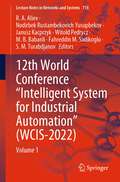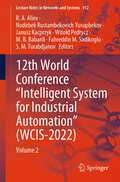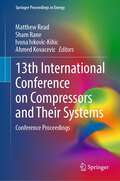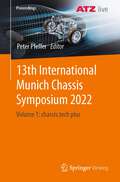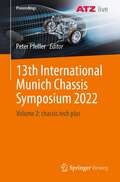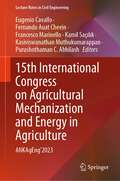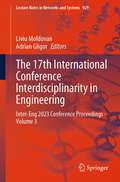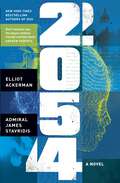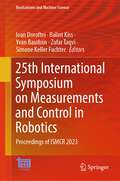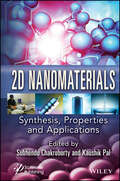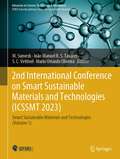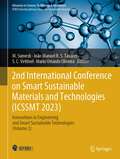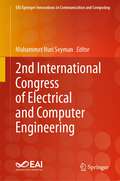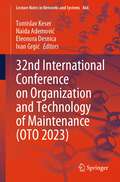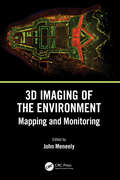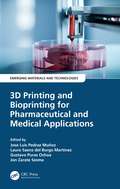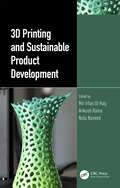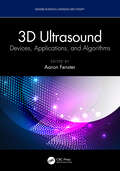- Table View
- List View
12th World Conference “Intelligent System for Industrial Automation”: Volume 1 (Lecture Notes in Networks and Systems #718)
by R. A. Aliev Nodirbek Rustambekovich Yusupbekov Janusz Kacprzyk Witold Pedrycz M. B. Babanli Fahreddin M. Sadikoglu S. M. TurabdjanovThis book presents the first volume of the proceedings of the 12th World Conference "Intelligent systems for industrial automation", WCIS-2022 held in Tashkent, Uzbekistan, on November 25-26, 2022. It includes contributions from diverse areas of intelligent industrial systems design, intelligent information systems, decision making under imperfect information and others. The topics of the papers include hybrid control systems, pattern recognition, industry 4.0, information security, neural computing, fuzzy computation, decision making and support systems, and others.
12th World Conference “Intelligent System for Industrial Automation”: Volume 2 (Lecture Notes in Networks and Systems #912)
by R. A. Aliev Nodirbek Rustambekovich Yusupbekov Janusz Kacprzyk Witold Pedrycz M. B. Babanli Fahreddin M. Sadikoglu S. M. TurabdjanovThis book presents the proceedings of the 12th World Conference "Intelligent systems for industrial automation", WCIS-2022 held in Tashkent, Uzbekistan, on November 25-26, 2022. It includes contributions from diverse areas of intelligent industrial systems design, intelligent information systems, decision making under imperfect information and others.The topics of the papers include hybrid control systems, pattern recognition, industry 4.0, information security, neural computing, fuzzy computation, decision making and support systems, and others.
13th International Conference on Compressors and Their Systems: Conference Proceedings (Springer Proceedings in Energy)
by Matthew Read Sham Rane Ivona Ivkovic-Kihic Ahmed KovacevicThis new proceedings discusses developments in air, gas and refrigeration compressors, vacuum pumps, and expanders. It is the 13th edition of the International Conference on Compressors and their Systems, a three-day conference organised by the Centre for Compressors Technology at City, University of London in collaboration with, among other, the MEchE, IIR, and IOR.The conference offers a platform to identify current challenges in the field and provide the essential content and direction to shape future research. The International Conference on Compressors and their Systems series began in 1999 as a result of industrial consultation and a need for academic collaboration. Initially, the conference was organised by the Fluid Machinery Group of the Institution of Mechanical Engineers (IMechE) with the support of Holroyd. From 2009, the Centre for Compressor Technology at City, University of London took over its management and the conference is now one of the main conventions, taking place biennially in the UK, becoming world-renowned for its place in industry and academia to gather and discuss a broad range of topical issues related to compressors and compression systems.This year's conference has the theme "Compressors and Expanders in Future Energy Systems” and will be of interest to researchers and engineers in industry.
13th International Munich Chassis Symposium 2022: Volume 1: chassis.tech plus (Proceedings)
by Peter PfefferThe increasing automation of driving functions and the electrification of powertrains present new challenges for the chassis with regard to complexity, redundancy, data security, and installation space. At the same time, the mobility of the future will also require entirely new vehicle concepts, particularly in urban areas. The intelligent chassis must be connected, electrified, and automated in order to be best prepared for this future.ContentsRedundant Systems and Testing.- New Systems and Concepts.- New Chassis and Systems.- Simulators.- Automated Driving: Development Methods.- Automated Driving: Driver and Security.- Steer-by-Wire.- Environmental Aspects.- New Brake Concepts and Methods.- Environmental Aspects.- Tires and the Environment.- Innovations in Tires and Wheels.- Vehicle Dynamics.- Digital Development.- Future Brake Systems.- Tires and Virtual Development.-Target audiencesAutomotive engineers and chassis specialists as well as students looking for state-of-the-art information regarding their field of activity - Lecturers and instructors at universities and universities of applied sciences with the main subject of automotive engineering - Experts, researchers and development engineers of the automotive and the supplying industry.PublisherATZ live stands for top quality and a high level of specialist information and is part of Springer Nature, one of the leading publishing groups worldwide for scientific, educational and specialist literature.PartnerTÜV SÜD is an international leading technical service organisation catering to the industry, mobility and certification segment.
13th International Munich Chassis Symposium 2022: Volume 2: chassis.tech plus (Proceedings)
by Peter PfefferThe increasing automation of driving functions and the electrification of powertrains present new challenges for the chassis with regard to complexity, redundancy, data security, and installation space. At the same time, the mobility of the future will also require entirely new vehicle concepts, particularly in urban areas. The intelligent chassis must be connected, electrified, and automated in order to be best prepared for this future.ContentsRedundant Systems and Testing.- New Systems and Concepts.- New Chassis and Systems.- Simulators.- Automated Driving: Development Methods.- Automated Driving: Driver and Security.- Steer-by-Wire.- Environmental Aspects.- New Brake Concepts and Methods.- Environmental Aspects.- Tires and the Environment.- Innovations in Tires and Wheels.- Vehicle Dynamics.- Digital Development.- Future Brake Systems.- Tires and Virtual Development.-Target audiencesAutomotive engineers and chassis specialists as well as students looking for state-of-the-art information regarding their field of activity - Lecturers and instructors at universities and universities of applied sciences with the main subject of automotive engineering - Experts, researchers and development engineers of the automotive and the supplying industry.PublisherATZ live stands for top quality and a high level of specialist information and is part of Springer Nature, one of the leading publishing groups worldwide for scientific, educational and specialist literature.PartnerTÜV SÜD is an international leading technical service organisation catering to the industry, mobility and certification segment.
15th International Congress on Agricultural Mechanization and Energy in Agriculture: ANKAgEng’2023 (Lecture Notes in Civil Engineering #458)
by Eugenio Cavallo Fernando Auat Cheein Francesco Marinello Kamil Saçılık Kasiviswanathan Muthukumarappan Purushothaman C. AbhilashThis volume highlights the latest advances, innovations, and applications in the field of agricultural technologies engineering, as presented by leading international researchers and engineers at the 15th International Congress on Agricultural Mechanization and Energy in Agriculture (ANKAgEng), held in Antalya, Turkey on October 29 – November 1, 2022. It covers a diverse range of topics such as machinery and energy systems, agriculture information technologies, digital-smart agriculture, ergonomics, health & safety, system engineering, post-harvest technologies & process engineering, sustainable agriculture, natural resources & environmental systems, plant, animal & facility systems, agricultural engineering education and biosystems engineering. The contributions, which were selected by means of a rigorous international peer-review process, present a wealth of exciting ideas that will open novel research directions and foster multidisciplinary collaboration among different specialists.
The 17th International Conference Interdisciplinarity in Engineering: Inter-Eng 2023 Conference Proceedings - Volume 3 (Lecture Notes in Networks and Systems #929)
by Liviu Moldovan Adrian GligorThis book contains research papers that were accepted for presentation at the 17th International Conference on Interdisciplinarity in Engineering—INTER-ENG 2023, which was held on 5–6 October 2023, in the city of Târgu Mureș, Romania. The general scope of the conference “Towards transition for a more competitive European industry in a smart, safe and sustainable future” is proposing a new approach related to the development of a new generation of smart factories grounded on the manufacturing and assembly process digitalization. It is related to advance manufacturing technology, lean manufacturing, sustainable manufacturing, additive manufacturing, manufacturing tools and equipment. It is a leading international professional and scientific forum of great interest for engineers and scientists who can read in this book research works contributions and recent developments as well as current practices in advanced fields of engineering.
2054: A Novel
by Elliot Ackerman Admiral James Stavridis‘A pacy, gripping page-turner of a thriller . . . Don’t venture into the future without having read this book’ Andrew RobertsFrom the acclaimed authors of the runaway New York Times bestseller 2034 comes an explosive work of speculative fiction about a radical leap forward in artificial intelligence that combines with America’s violent partisan divide to create an existential threat to the country – and the world.The year is 2054. It is twenty years after the nuclear war between the United States and China that brought down the old American political order. The new American Dream Party has emerged in the US and held power for over a decade. Many fear the president will stop at nothing to remain in the White House. Suddenly, he collapses in the middle of an address to the nation. After a flurry of misinformation, the administration reluctantly announces his death. A cover-up ensues, conspiracy theories spread like wildfire and the country descends into civil war.A handful of elite actors from the worlds of computer science, intelligence and business have a fairly good idea what happened. All signs point to a profound breakthrough in AI, of which the remote assassination of an American president is hardly the most game-changing ramification. The trail leads to an outpost in the Amazon rainforest: the last known whereabouts of the tech visionary who predicted this breakthrough. As some of the world’s great powers – old and new, state and nonstate alike – struggle to outmanoeuvre one another in this new Great Game of scientific discovery, the outcome becomes entangled with the fate of democracy itself.Combining a deep understanding of AI, biotech and the possibility of a coming singularity, along with their signature geopolitical sophistication, Elliot Ackerman and Admiral James Stavridis have once again written a visionary work. 2054 is a novel that reads like a thriller even as it demands that we consider the trajectory of our society and its potentially calamitous destination.
The 25th European Conference on Integrated Optics: Proceedings of ECIO 2024, June 17–19, Aachen, Germany (Springer Proceedings in Physics #402)
by Jeremy Witzens Joyce Poon Lars Zimmermann Wolfgang FreudeThis volume presents peer-reviewed and selected papers from the 2024 European Conference on Integrated Optics (ECIO), held on 17-19 June, 2024, and organized by RWTH Aachen University, Germany, in collaboration with Max-Planck Institute of Microstructure Physics, Technical University of Berlin, Leibniz Institute for High Performance Microelectronics, and Karlsruhe Institute of Technology. In the 25th edition of this conference, internationally recognized experts share their latest research and showcase their products and services in the field of integrated optics, optoelectronics, and nano-photonics. The conference focuses on leading-edge research and its broad application scope ranges from tele/datacom, optical interconnects, and (bio) optical sensing to more disruptive areas such as quantum computing and programmable photonics.
25th International Symposium on Measurements and Control in Robotics: Proceedings of ISMCR 2023 (Mechanisms and Machine Science #154)
by Ioan Doroftei Balint Kiss Yvan Baudoin Zafar Taqvi Simone Keller FuchterGathering the proceedings of the 25th International Symposium on Measurement and Control in Robotics (ISMCR), held in Iasi, Romania, on September 21-22, 2023, this volume covers topics in the broad range of topics related to robotics and human robot systems, such as robot design innovations, sensors/smart sensors their integration/fusion, advanced controls and actuators, methods of AI in robotics, humanoid, climbing/walking, and autonomous robots; anthropomorphic robots, augmented/mixed/virtual reality (VR), intelligent CAD and IMS, visual/auditory/tactile/force displays, tools and techniques for modelling VR systems, software architectures for VR, VR interaction and navigation techniques, distributed VR Systems, motion tracking, VR input and output devices, human factors in VR. The proceedings extend this platform to all researchers, scientists, industry experts, and students interested in these fields.
2D Nanomaterials: Synthesis, Properties, and Applications
by Subhendu Chakroborty Kaushik Pal2D NANOMATERIALS The book provides a comprehensive overview of the synthesis, modification, characterization, and application of 2D nanomaterials. In recent years, 2D nanomaterials have emerged as a remarkable cornerstone in the field of advanced materials research, with their unique properties and versatile applications captivating the attention of scientists and engineers worldwide. This book is a testament to the ever-growing interest and importance of 2D nanomaterials in the realm of materials science, nanotechnology, pharmaceuticals, and a myriad of engineering specializations. The book is structured into three sections, each delving into different aspects of 2D nanomaterials. The first section explores the synthesis of these materials, providing an overview of both top-down and bottom-up strategies. Understanding the methods by which these materials can be synthesized is crucial for advancing their potential applications. Additionally, this section details the structural characterization of 2D nanomaterials, shedding light on their intricate compositions and properties. The second section examines the diverse characteristics exhibited by 2D nanomaterials. From their magnetic and mechanical properties to their electrical, plasmonic, and optical behaviors, these materials possess an array of intriguing attributes that make them highly attractive for a wide range of applications. This section of the book provides a comprehensive understanding of these properties, enabling readers to appreciate the unique potential of 2D nanomaterials. The final section focuses on the applications of 2D nanomaterials, highlighting their use in various fields such as energy, water purification, biomedical applications, multimodal tumor therapy, and supercapacitor technology.
2D Nanomaterials: Synthesis, Properties, and Applications
by Subhendu Chakroborty Kaushik Pal2D NANOMATERIALS The book provides a comprehensive overview of the synthesis, modification, characterization, and application of 2D nanomaterials. In recent years, 2D nanomaterials have emerged as a remarkable cornerstone in the field of advanced materials research, with their unique properties and versatile applications captivating the attention of scientists and engineers worldwide. This book is a testament to the ever-growing interest and importance of 2D nanomaterials in the realm of materials science, nanotechnology, pharmaceuticals, and a myriad of engineering specializations. The book is structured into three sections, each delving into different aspects of 2D nanomaterials. The first section explores the synthesis of these materials, providing an overview of both top-down and bottom-up strategies. Understanding the methods by which these materials can be synthesized is crucial for advancing their potential applications. Additionally, this section details the structural characterization of 2D nanomaterials, shedding light on their intricate compositions and properties. The second section examines the diverse characteristics exhibited by 2D nanomaterials. From their magnetic and mechanical properties to their electrical, plasmonic, and optical behaviors, these materials possess an array of intriguing attributes that make them highly attractive for a wide range of applications. This section of the book provides a comprehensive understanding of these properties, enabling readers to appreciate the unique potential of 2D nanomaterials. The final section focuses on the applications of 2D nanomaterials, highlighting their use in various fields such as energy, water purification, biomedical applications, multimodal tumor therapy, and supercapacitor technology.
2nd International Conference on Smart Sustainable Materials and Technologies: Smart Sustainable Materials and Technologies (Volume 1) (Advances in Science, Technology & Innovation)
by M. Sumesh João Manuel R. S. Tavares S. C. Vettivel Mario Orlando OliveiraSustainable materials science and engineering is one of the important characteristics of the existing high-tech revolution. The advances of materials science pave way for technical advancements in materials science and industrial technologies throughout the world. Materials are regarded as critical component in all emerging industries. Exquisite preparation and manufacturing must be carried out before a new material may be used. Nevertheless, electronic materials are undeniably important in many aspects of life. Smart materials and structures is a multi-disciplinary platform dedicated to technical advances in smart materials, systems and structures, including intelligent materials, sensing and actuation, adaptive structures, and active control. Recently, sustainable materials and technologies reshape the electronics industry to build realistic applications. At present, without the impact of sustainability, the electronics industry faces challenges. Researchers are now more focused on understanding the fundamental science of nano, micro, and macro-scale aspects of materials and technologies for sustainable development with a special attention toward reducing the knowledge gap between materials and system designs. The main aim of this international conference is to address the new trends on smart sustainable materials field for industrial and electronics applications. The main purpose of this conference is to assess the recent development in the applied science involving research activity from micro- to macro-scale aspects of materials and technologies for sustainable applications. In such a context, particular emphasis is given to research papers tailored in order to improve electronic and industrial applications and market extension of sustainable materials.
2nd International Conference on Smart Sustainable Materials and Technologies: Innovations in Engineering and Smart Sustainable Technologies (Volume 2) (Advances in Science, Technology & Innovation)
by M. Sumesh João Manuel R. S. Tavares S. C. Vettivel Mario Orlando OliveiraSustainable materials science and engineering is one of the important characteristics of the existing high-tech revolution. The advances of materials science pave way for technical advancements in materials science and industrial technologies throughout the world. Materials are regarded as critical component in all emerging industries. Exquisite preparation and manufacturing must be carried out before a new material may be used. Nevertheless, electronic materials are undeniably important in many aspects of life. Smart materials and structures is a multi-disciplinary platform dedicated to technical advances in smart materials, systems and structures, including intelligent materials, sensing and actuation, adaptive structures, and active control. Recently, sustainable materials and technologies reshape the electronics industry to build realistic applications. At present, without the impact of sustainability, the electronics industry faces challenges. Researchers are now more focused on understanding the fundamental science of nano, micro, and macro-scale aspects of materials and technologies for sustainable development with a special attention toward reducing the knowledge gap between materials and system designs. The main aim of this international conference is to address the new trends on smart sustainable materials field for industrial and electronics applications. The main purpose of this conference is to assess the recent development in the applied science involving research activity from micro- to macro-scale aspects of materials and technologies for sustainable applications. In such a context, particular emphasis is given to research papers tailored in order to improve electronic and industrial applications and market extension of sustainable materials.
2nd International Congress of Electrical and Computer Engineering (EAI/Springer Innovations in Communication and Computing)
by Muhammet Nuri SeymanThis proceedings presents the papers included in the 2nd International Congress of Electrical and Computer Engineering (ICECENG), which took place in Bandirma, Turkey, 22-25 November 2023. The conference aims to bring together researchers, developers, and students in computing, technology trends, artificial intelligence, and security who are interested in studying the application of formal methods to the construction and analysis of models describing technological processes at both micro and macro levels. ICECENG’23 also aims to provide a platform for discussing the issues, challenges, opportunities, and findings of computer engineering research. The conference seeks to provide some answers and explore the processes, actions, challenges, and outcomes of learning and teaching.
3 Degrees More: The Impending Hot Season and How Nature Can Help Us Prevent It
by Klaus WiegandtThis open access book describes in detail what life on this planet would be like if its average surface temperature were to rise 3 degrees Celsius above the preindustrial level. On this basis, the book argues that it is imperative to keep this temperature rise below 2 degrees Celsius. It then lays out a detailed plan of what politically feasible, cost-effective measures should now be taken to achieve this goal. In this context, the book provides detailed discussions of climate finance, climate education and nature-based solutions. The book has been translated into English from the original German version published in 2022, and contains an original foreword and preface.
32nd International Conference on Organization and Technology of Maintenance (Lecture Notes in Networks and Systems #866)
by Tomislav Keser Naida Ademović Eleonora Desnica Ivan GrgićThis book presents papers submitted at 32nd International Conference on Organization and Technology of Maintenance (OTO 2023) held on December 12, 2023, at Osijek, Republic of Croatia. The objective of this conference is to promote, standardize, and support efforts to gain new knowledge in areas that are intimately tied to technical and social systems and where maintenance of any kind is of utmost importance. By bringing together experts from various fields, this conference aims to foster collaboration and the exchange of ideas, ultimately leading to advancements in both technical and social systems. Additionally, it seeks to create a platform for discussing best practices and innovative approaches in maintenance, ensuring the sustainability and efficiency of these systems in the long run. Furthermore, the upkeep of technological and social systems, along with their accessibility and dependability, significantly influences the long-term sustainability and economic feasibility of their functioning. Periodic and condition-based maintenance are integral components of the various systems, influencing their operational efforts and outcomes. By providing a space for professionals to exchange ideas and experiences, this platform facilitates the identification and implementation of cutting-edge maintenance strategies. Moreover, it recognizes the importance of addressing emerging challenges such as digitalization and environmental impact in order to ensure the continued effectiveness of these systems. Conference topics will address maintenance challenges in the areas of machine design, maintenance technologies in general, organization and management of maintenance proposals and procedures, quality management in system maintenance, information systems, product life cycle management, design for maintainability, material and structural properties, diagnosis and prediction of failures and breakdowns, design optimization for maintenance, analysis of maintenance efficiency and cost-effectiveness, civil, mechanical and electrical engineering, etc.
3D Imaging of the Environment: Mapping and Monitoring
by John MeneelyThis is a comprehensive, overarching, interdisciplinary book and a valuable contribution to a unified view of visualisation, imaging, and mapping. It covers a variety of modern techniques, across an array of spatial scales, with examples of how to map, monitor, and visualise the world in which we live. The authors give detailed explanations of the techniques used to map and monitor the built and natural environment and how that data, collected from a wide range of scales and cost options, is translated into an image or visual experience. It is written in a way that successfully reaches technical, professional, and academic readers alike, particularly geographers, architects, geologists, and planners. FEATURES Includes in-depth discussion on 3D image processing and modeling Focuses on the 3D application of remote sensing, including LiDAR and digital photography acquired by UAS and terrestrial techniques Introduces a broad range of data collection techniques and visualisation methods Includes contributions from outstanding experts and interdisciplinary teams involved in earth sciences Presents an open access chapter about the EU-funded CHERISH Project, detailing the development of a toolkit for the 3D documentation and analysis of the combined coastline shared between Ireland and Wales Intended for those with a background in the technology involved with imaging and mapping, the contributions shared in this book introduce readers to new and emerging 3D imaging tools and programs.
3D Imaging of the Environment: Mapping and Monitoring
This is a comprehensive, overarching, interdisciplinary book and a valuable contribution to a unified view of visualisation, imaging, and mapping. It covers a variety of modern techniques, across an array of spatial scales, with examples of how to map, monitor, and visualise the world in which we live. The authors give detailed explanations of the techniques used to map and monitor the built and natural environment and how that data, collected from a wide range of scales and cost options, is translated into an image or visual experience. It is written in a way that successfully reaches technical, professional, and academic readers alike, particularly geographers, architects, geologists, and planners. FEATURES Includes in-depth discussion on 3D image processing and modeling Focuses on the 3D application of remote sensing, including LiDAR and digital photography acquired by UAS and terrestrial techniques Introduces a broad range of data collection techniques and visualisation methods Includes contributions from outstanding experts and interdisciplinary teams involved in earth sciences Presents an open access chapter about the EU-funded CHERISH Project, detailing the development of a toolkit for the 3D documentation and analysis of the combined coastline shared between Ireland and Wales Intended for those with a background in the technology involved with imaging and mapping, the contributions shared in this book introduce readers to new and emerging 3D imaging tools and programs.
3D Printing and Bioprinting for Pharmaceutical and Medical Applications (Emerging Materials and Technologies)
by Jose Luis Pedraz Muñoz Laura Saenz del Burgo Martínez Gustavo Puras Ochoa Jon Zarate SesmaThe increasing availability and decreasing costs of 3D printing and bioprinting technologies are expanding opportunities to meet medical needs. 3D Printing and Bioprinting for Pharmaceutical and Medical Applications discusses emerging approaches related to these game-changer technologies in such areas as drug development, medical devices, and bioreactors. Key Features: Offers an overview of applications, the market, and regulatory analysis Analyzes market research of 3D printing and bioprinting technologies Reviews 3D printing of novel pharmaceutical dosage forms for personalized therapies and for medical devices, as well as the benefits of 3D printing for training purposes Covers 3D bioprinting technology, including the design of polymers and decellularized matrices for bio-inks development, elaboration of 3D models for drug evaluation, and 3D bioprinting for musculoskeletal, cardiovascular, central nervous system, ocular, and skin applications Provides risk-benefit analysis of each application Highlights bioreactors, regulatory aspects, frontiers, and challenges This book serves as an ideal reference for students, researchers, and professionals in materials science, bioengineering, the medical industry, and healthcare.
3D Printing and Bioprinting for Pharmaceutical and Medical Applications (Emerging Materials and Technologies)
The increasing availability and decreasing costs of 3D printing and bioprinting technologies are expanding opportunities to meet medical needs. 3D Printing and Bioprinting for Pharmaceutical and Medical Applications discusses emerging approaches related to these game-changer technologies in such areas as drug development, medical devices, and bioreactors. Key Features: Offers an overview of applications, the market, and regulatory analysis Analyzes market research of 3D printing and bioprinting technologies Reviews 3D printing of novel pharmaceutical dosage forms for personalized therapies and for medical devices, as well as the benefits of 3D printing for training purposes Covers 3D bioprinting technology, including the design of polymers and decellularized matrices for bio-inks development, elaboration of 3D models for drug evaluation, and 3D bioprinting for musculoskeletal, cardiovascular, central nervous system, ocular, and skin applications Provides risk-benefit analysis of each application Highlights bioreactors, regulatory aspects, frontiers, and challenges This book serves as an ideal reference for students, researchers, and professionals in materials science, bioengineering, the medical industry, and healthcare.
3D Printing and Sustainable Product Development
by Haq, Mir Irfan Ul Ankush Raina Nida NaveedThe text focuses on the role and the importance of 3D printing in new product development processes. It covers various aspects such as the 3D printing revolution and Industry 4.0, sustainability and 3D printing, and economics of 3D printing. It discusses important concepts, including 3D printing, rapid prototyping, mechanical and physical properties of 3D printed parts, nanomaterials, and material aspects of 3D printing. Features 1. Presents recent advances such as Industry 4.0, 4D printing, 3D material mechanical characterization, and printing of advanced materials. 2. Highlights the interdisciplinary aspects of 3D printing, particularly in biomedical, and aerospace engineering. 3. Discusses mechanical and physical properties of 3D printed parts, material aspects, and process parameters. 4. Showcases topics such as rapid prototyping, medical equipment design, and biomimetics related to the role of 3D printing in new product development. 5.Covers applications of 3D printing in diverse areas, including automotive, aerospace engineering, medical, and marine industry. It will serve as an ideal reference text for senior undergraduate, graduate students, and researchers in diverse engineering domains, including manufacturing, mechanical, aerospace, automotive, and industrial.
3D Printing and Sustainable Product Development
The text focuses on the role and the importance of 3D printing in new product development processes. It covers various aspects such as the 3D printing revolution and Industry 4.0, sustainability and 3D printing, and economics of 3D printing. It discusses important concepts, including 3D printing, rapid prototyping, mechanical and physical properties of 3D printed parts, nanomaterials, and material aspects of 3D printing. Features 1. Presents recent advances such as Industry 4.0, 4D printing, 3D material mechanical characterization, and printing of advanced materials. 2. Highlights the interdisciplinary aspects of 3D printing, particularly in biomedical, and aerospace engineering. 3. Discusses mechanical and physical properties of 3D printed parts, material aspects, and process parameters. 4. Showcases topics such as rapid prototyping, medical equipment design, and biomimetics related to the role of 3D printing in new product development. 5.Covers applications of 3D printing in diverse areas, including automotive, aerospace engineering, medical, and marine industry. It will serve as an ideal reference text for senior undergraduate, graduate students, and researchers in diverse engineering domains, including manufacturing, mechanical, aerospace, automotive, and industrial.
3D Ultrasound: Devices, Applications, and Algorithms (Imaging in Medical Diagnosis and Therapy)
3D ultrasound techniques have been increasingly used in diagnosis, minimally invasive image-guided interventions, and intra-operative surgical use. Today, most ultrasound system manufacturers provide 3D imaging capability as part of the systems. This availability has stimulated researchers to develop various machine learning tools to automatically detect and diagnose diseases, such as cancer, monitor the progression and regression of diseases, such as carotid atherosclerosis, guide and track tools being introduced into the body, such as brachytherapy and biopsy needles. This edited book is divided into three sections covering 3D ultrasound devices, 3D ultrasound applications, and machine learning tools using 3D ultrasound imaging and written with physicians, engineers, and advanced graduate students in mind. Features: Provides descriptions of mechanical, tracking, and array approaches for generating 3D ultrasound images Details the applications of 3D ultrasound for diagnostic application and in image-guided intervention and surgery Explores the cutting-edge use of machine learning in detection, diagnosis, monitoring, and guidance for a variety of clinical applications
3D Ultrasound: Devices, Applications, and Algorithms (Imaging in Medical Diagnosis and Therapy)
by Aaron Fenster3D ultrasound techniques have been increasingly used in diagnosis, minimally invasive image-guided interventions, and intra-operative surgical use. Today, most ultrasound system manufacturers provide 3D imaging capability as part of the systems. This availability has stimulated researchers to develop various machine learning tools to automatically detect and diagnose diseases, such as cancer, monitor the progression and regression of diseases, such as carotid atherosclerosis, guide and track tools being introduced into the body, such as brachytherapy and biopsy needles. This edited book is divided into three sections covering 3D ultrasound devices, 3D ultrasound applications, and machine learning tools using 3D ultrasound imaging and written with physicians, engineers, and advanced graduate students in mind. Features: Provides descriptions of mechanical, tracking, and array approaches for generating 3D ultrasound images Details the applications of 3D ultrasound for diagnostic application and in image-guided intervention and surgery Explores the cutting-edge use of machine learning in detection, diagnosis, monitoring, and guidance for a variety of clinical applications
